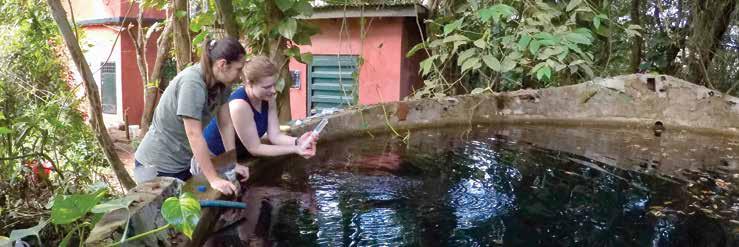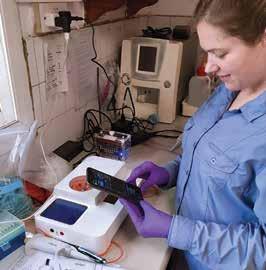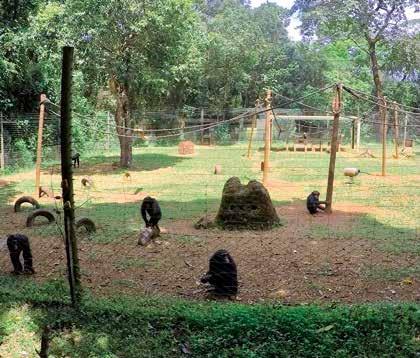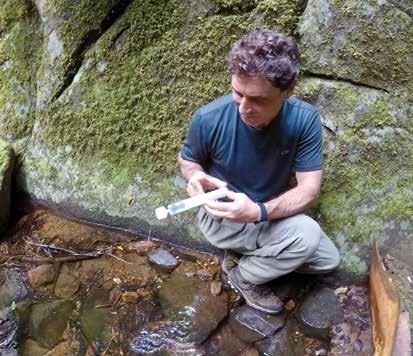
5 minute read
Comparatively Speaking
Graduate student Leah Owens and Tacugama general manager Andrea Pizzaro sample a water reservoir at the chimpanzee sanctuary to search for signs of disease-causing bacteria.
Mystery Disease at Chimpanzee Sanctuary Linked to Bacterial Infection
Advertisement
In 2005, chimpanzees at the Tacugama Chimpanzee Sanctuary in Freetown, Sierra Leone, started getting sick. They would stumble, vomit, and stop eating.
The illness came on quickly; some chimps were found dead before caretakers even knew they were sick. Searches for parasites, toxic plants, or viruses responsible for the disease came up empty. Treatment couldn’t stave off death. Since then, 56 chimpanzees at the sanctuary have died of the mysterious illness, which has been dubbed epizootic neurologic and gastroenteric syndrome, or ENGS.
But a new study published in Nature Communications by researchers from the University of Wisconsin–Madison, Tacugama, and an international team of colleagues reveals that an overlooked bacterial group known as Sarcina is linked to the syndrome. Researchers found that most chimps sick with ENGS had Sarcina in their gut, and some harbored the bacteria in their livers, spleens, and brains. The bacteria did not appear in any healthy chimpanzees.
The findings are helpful guidance for individuals treating sick chimpanzees at Tacugama, part of the Pan African Sanctuary Alliance, which supported the research because the results could aid other chimpanzee sanctuaries.
The study also suggests that Sarcina, which has only rarely been linked to disease in humans, may be more common, and capable of more serious infections in people and animals, than previously thought. Yet there is little concern over animalto-human transmission, and for now the disease remains rare in humans.
“We may have identified an overlooked cause of human and animal disease,” says Tony Goldberg, a professor of epidemiology in the UW School of Veterinary Medicine who led the research. “This may be a group of species, some of which are perfectly normal soil bacteria, and some of which are deadly pathogens.”
ENGS shows varied symptoms in chimps, suggesting that both their digestive and neurological systems are damaged. After years of struggling to pinpoint the cause, veterinarians at Tacugama reached out to Goldberg, who studies emerging diseases and uncovers novel pathogens using genetic sequencing. Thanks to years of detailed veterinary work, Tacugama had tissue samples from both sick and healthy chimps they could share with Goldberg’s lab to search for pathogens. Once the samples were in Madison, Goldberg lab members used genetic sequencing techniques to look for known and unknown viruses, bacteria, and parasites. Just one group of bacteria emerged in tissues from sick chimpanzees — those from the Clostridiaceae family, which are linked to tetanus, botulism, and other diseases. Graduate student Leah Owens of the Comparative Biomedical Sciences program and other scientists involved in the study were able to detect the bacterium in the organs of ill chimps — but not healthy ones. They were even able to see it in the brain of one chimp named Joko who had succumbed to the disease. In a pivotal

Leah Owens, a dual degree DVM/PhD student with the UW School of Veterinary Medicine, looks for signs of disease-causing bacteria in samples from the Tacugama Chimpanzee Sanctuary.
Chimpanzees in an enclosure at the Tacugama Chimpanzee Sanctuary in Freetown, Sierra Leone. Several dozen chimpanzees at Tacugama have succumbed to a mysterious disease linked to a bacterial infection. UW School of Veterinary Medicine professor Tony Goldberg samples water at the Tacugama Chimpanzee Sanctuary to search for evidence of disease-causing bacteria.

moment, Owens was able to see the telltale four-leaf-clover shape of the bacteria she knew from genetic analysis must have been in the tissue samples: Sarcina.
“We were still unsure what this bacterium was doing in the chimps, but we were very sure that it should not have been in the brain,” says Goldberg.
In late 2019, Goldberg and Owens traveled to Tacugama. They searched for sources of the mystery pathogen by collecting samples of soil, water, and food.
From those environmental samples, Owens was able to detect the bacterium using specific tests that she and Goldberg had designed back in Wisconsin. Owens was also able to grow the Sarcina bacterium in the lab. She succeeded in producing enough of it that study co-authors at the Naval Medical Research Center in Maryland were able to sequence the bacteria’s genome.
“Within that genome we found several different biochemical pathways that are associated with pathogenicity,” says Owens, first author of the study.
The genome also revealed that the new bacteria, despite resembling other Sarcina microbes, was a new species. The researchers named the new species Sarcina troglodytae after the scientific name for chimpanzees, Pan troglodytes.
Owens, who has pored over every report of Sarcina infection ever reported in humans and animals, says that identifying the species as pathogenic may help clinicians spot more cases of infection going forward. Yet it remains unclear how common Sarcina infection is in people, or how serious the infection might typically be.
In recent years, fewer chimpanzees at Tacugama have succumbed to ENGS. Veterinarians at the sanctuary have learned to identify sick animals sooner and developed treatments inspired by the identification of Sarcina as a contributing cause of the disease.

From the CBMS Director
Looking Back and Ahead
Wow, has it been seven years already since I assumed directorship of the Comparative Biomedical Sciences (CBMS) graduate program? It has been my honor, privilege, and pleasure to lead this storied graduate program, which has a sustained and enviable record of providing outstanding training to biomedical scientists for over 100 years.
It is gratifying that the CBMS program has grown into a truly multidisciplinary and vibrant, nationally ranked top-five program. We have more than 100 trainers with significant strengths in several specialty areas, including infectious disease, developmental biology, neuroscience, vector biology, regenerative medicine, and cancer research.
I have immensely enjoyed interacting with an outstanding group of graduate students, trainers, and members of the CBMS academic committee, as well as the talented and dedicated program coordinators Kathy Holtgraver and Susan Thideman.
This spring, I stepped down as CBMS director. I have assumed the directorship of a National Institutes of Health-funded program to train veterinarians in biomedical research and, in September, will become the school’s next associate dean for research and graduate training.
I am delighted to announce that Lyric Bartholomay PhD’04, a professor in pathobiological sciences at the School of Veterinary Medicine who also co-leads the Midwest Center of Excellence for Vector-Borne Disease, is the new CBMS director — and an alumna of the program. I expect the program to become even more diverse and reach new heights under her dynamic and insightful leadership in the coming years. On Wisconsin!
M. Suresh
John E. Butler Professor, Department of Pathobiological Sciences Immediate past director, Comparative Biomedical Sciences Program







